The former Glenbrook Railway Tunnel and Mustard Gas Storage Depot has outstanding significance as one of a series of only four tunnels, in NSW that physically embody Australian policy towards bulk chemical gas storage during World War Two for defensive purposes on
home soil. The presence of the gas for use only when the opposition attacked with chemical weapons, represents Australia's ongoing commitment to honouring the articles of the 1925 Geneva Protocol to which Australia submitted an instrument of ratification in 1930. It also demonstrates Australia's increasing awareness and fear of the threat posed by Axis forces, particularly Japan and the preparedness of Australia and the Allied Forces to employ antihumanitarian weapons widely condemned in World War One, in the event that the Axis powers used such weapons in an attack.
In 1913 the Glenbrook tunnel was leased from NSW Railways by Herbert Edward Rowe, an out of work master builder. Previously a Stan Breakspear had fenced off an area close to the tunnel where he kept a bull. The Rowes had the idea of growing mushrooms in the tunnel. They created living quarters from an old circus tent, a small
cave and a culvert under the highway. Herbert Rowe built his own mushroom growing beds which were three metres wide with a narrow path down the left side for access and working space. About three quarters of the length of the tunnel was taken up by the beds. When the Rowes renewed their lease in 1936 the Commissioner of Railways warned them that in the event of war, they would be given three months notice to vacate the site. The Rowes are believed to have actually been given only one weeks notice to vacate the site when war broke out in September 1939.
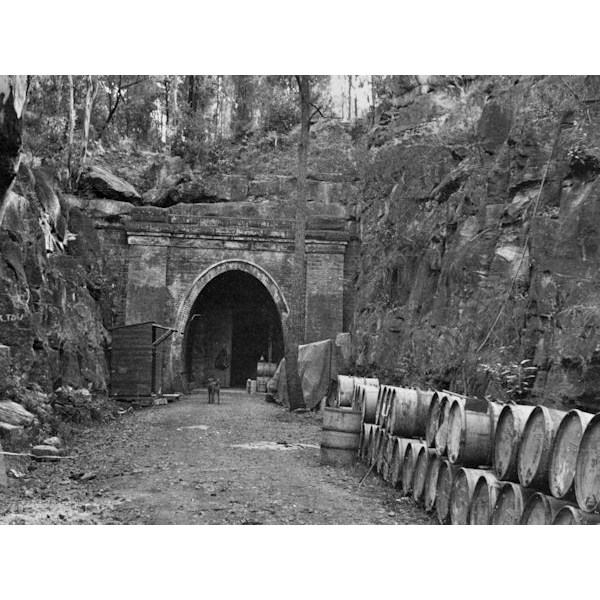
Mustard gas storage - Eastern end of Glenbrook Chemical warfare storage tunnel
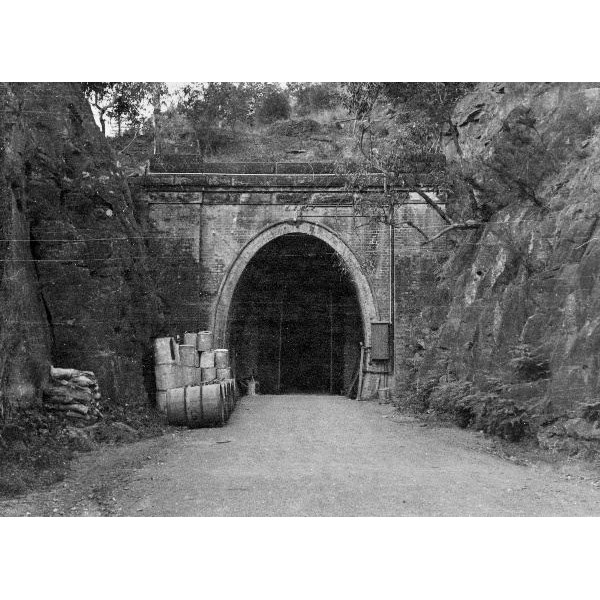
Mustard gas storage - Western end of Glenbrook Chemical warfare storage tunnel

Mustard gas drums in bond after venting at the Eastern Cutting of Glenbrook Tunnel
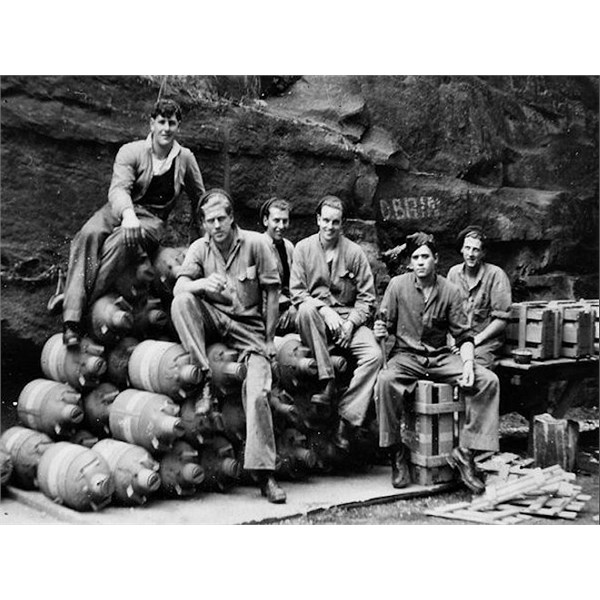
RAAF Chemical warfare Armours, (The Mustard Men) at the Glenbrook Tunnel
In 1930 Australia ratified the 1925 Geneva Protocol which banned the use of asphyxiating, poisonous or other gases in times of war for offensive purposes, following the experiences of chemical warfare during World War One.
The Geneva Protocol was drawn up and signed at the conference for the supervision of the international trade in arms and ammunition, which was held in Geneva under the auspices of the League of Nations from 4 May to 17 June 1925. France suggested that a protocol be drawn up on non-use of poisonous gases. At Poland's suggestion the prohibition was extended to bacteriological weapons. In the years prior to World War Two most major powers ratified the protocol, except the U.S. and Japan. The British reserved the right to waive the protocol if in time of war their enemies disregarded the terms of the agreement. Countries around the world have continued to ratify the Protocol until at least 1991.
Australia's ratification of the protocol was influenced by the experiences of Australian World War One soldiers who had suffered form the deadly and debilitating effects of gas exposure, particularly on the Western Front. Many were killed or maimed as the result of chemical attacks. The physical effects on survivors were clearly visible to those at
home upon their return.
By 1937, two years before World War Two commenced, Australia was already giving preliminary consideration to the need for procurement of gas for war time defence purposes. Early in 1942 the Japanese southward advance, particularly the fall of Singapore, caused Australia to prepare for possible invasion. Of particular concern was whether Japan would use chemical weapons as it had in China. Australia requested chemical warfare stocks from Britain in March. The response from Britain to supply Australia was swift and the first supplies docked in Australia in May 1942. Later stocks would also come from the
United States. Australia would eventually hold close to 1 million individual chemical munitions weapons, including at least 16 different types of mustard gas. Thirtyfive types of chemical weapons were eventually located at fifteen major storage depots across Australia.

250-lb phosgene bombs in sheds at the Marrangaroo Tunnel cutting
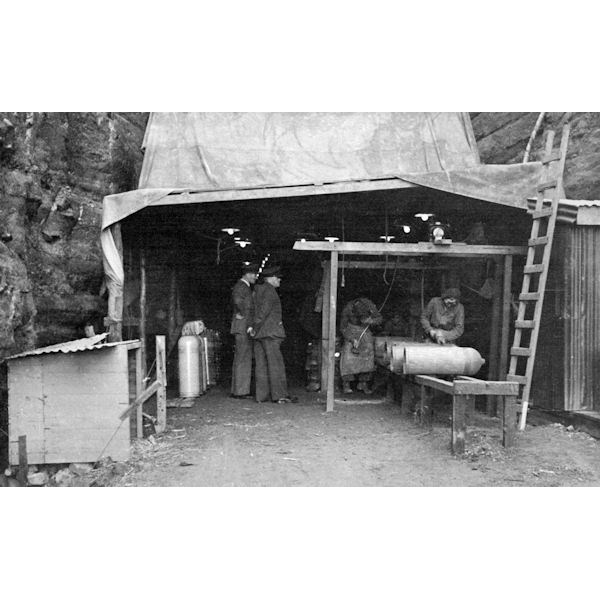
250 lb bombs being cleaned at the Marrangaroo tunnel

250 lb mustard gas bombs are undegoing maintenance in the Marrangaroo cutting.
The first stocks of chemical weapons destined for the RAAF were stored in the Blue Mountains while those for the army went to Albury. Naval stocks were stored at the Newington Depot in
Sydney. The RAAF stocks were stored in disused tunnels, chosen because of the lower fluctuation in temperature, protection from high temperatures and constant humidity. In
places such as Malaya, caves were used for the same purposes and the tunnels were anticipated to simulate the same conditions as
the caves. Industrial scale production or bulk manufacturing of chemical warfare agents did not and has not taken place within Australia, although some chemical agents have been produced here as by-products of other industrial processes or in bulk for other purposes. There has also been small scale manufacture of chemical agents for experimental and testing purposes.
The Glenbrook tunnel was one of fifteen bulk chemical storage facilities established in Australia - seven in New South Wales, six in Queensland, one in the Northern Territory and one in Victoria. Six were supervised by the
United States, including Kingswood in NSW, and the remainder by Australia. Only four of these included tunnels for storage purposes. These were Marrangaroo, Glenbrook and Clarence in the Blue Mountains and Picton south of
Sydney. They were all Australian supervised sites. Marrangaroo and Glenbrook were the first of the tunnels established followed by Picton and then Clarence. The Picton tunnel was constructed as part of the original main southern railway line. The remaining three were a part of the Zig Zag railway line. The four tunnels formed the base for the Royal Australian Air Force's No 1 Central Reserve. The headquarters for No 1CR were based at the combined RAAF-Army depot at Marangaroo, several kilometres from the Marangaroo tunnel. No 1 CR acted as a central depot for chemical and non chemical stocks and as a replenishment centre for NSW. The location of the tunnels also placed them out of the range of aircraft carriers and out of aerial view, thus protecting them from air attack.
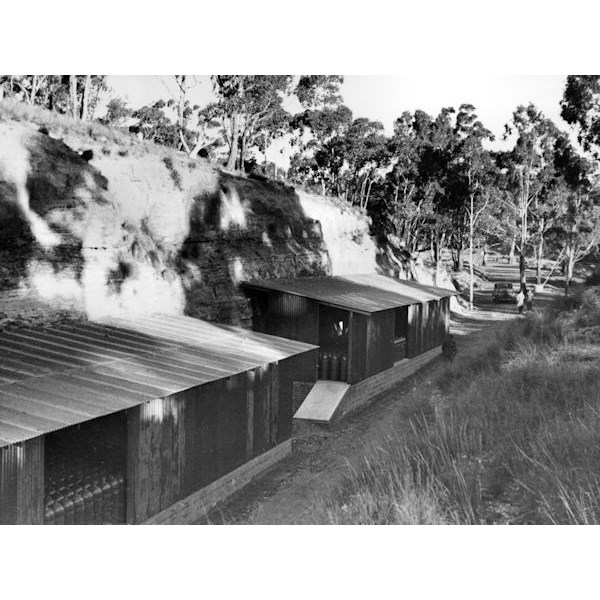
Phosgene Bomb Storage at Marrangaroo
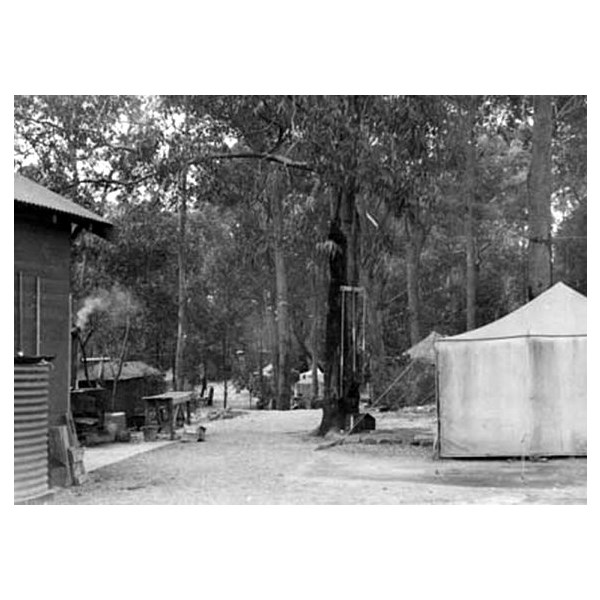
View of Glenbrook camp area from the West end
The British oversaw the initial establishment of chemical agents handling procedures. On 6 January 1942 the Air Board approved the take-over of the disused 660 metre railway tunnel at Glenbrook by the Royal Australian Air Force (RAAF) for the storage of bombs. On 9 August 1942 arrangements for the first intake of chemicals at Glenbrook were advised with material being received from the ship MV Nigerstrromm. When further supplies of chemicals arrived it was decided to move high explosive stocks from Glenbrook and Picton and devote these tunnels to gas stocks alone. Glenbrook housed mainly mustard gas from late August 1942. The RAAF stacked the Glenbrook tunnel from end to end with containers to store thousands of tonnes of mustard gas, a thick fluid that looked like oil. To accommodate facilities for maintenance and inspection, venting and decanting containers and decontamination of damaged hardware, an area was set up in the lower/eastern end cutting leading from the tunnel.
Additional shipments of gas in 1943-44 compelled the commissioning of Clarence tunnel to take the overflow. By 7 February 1944 the transfer of chemical weapons stocks from No. 2 Sub Depot, Glenbrook to Clarence Tunnel began. By August 1944 the RAAF decided that chemical weapons stocks and equipment other than obsolete items should be held substantially in forward areas and that 1 CR would become a transit point rather than a storage area to facilitate the supply of chemical weapons to forward unit should retaliatory chemical warfare action be sanctioned. two storage locations were subsequently chosen in north eastern Australia.
During the peak period for the arrival of chemicals from Great Britain and the African desert zone Glenbrook
railway siding was inadequate for the transport operations and associated influx of railway wagons and motor vehicles. Therefore, trains were kept at Penrith and batches of 14-20 wagons brought to Glenbrook as required.
In 1946, following the end of the war, the Australian Defence Committee agreed to the Army and RAAF requests to dispose of chemical ammunition. The Australian Government faced a dilemma as to how to dispose of the stocks of chemicals. Neither the Army or the Air Force had experience with disposal. As a result, trials were conducted to determine the best form of large scale chemical destruction. Burning, sea dumping and venting were found appropriate for the different types of chemicals. Fire was found to be the most appropriate for mustard gas. Gas was burned from storage sites at Talmoi and 88 Mile.
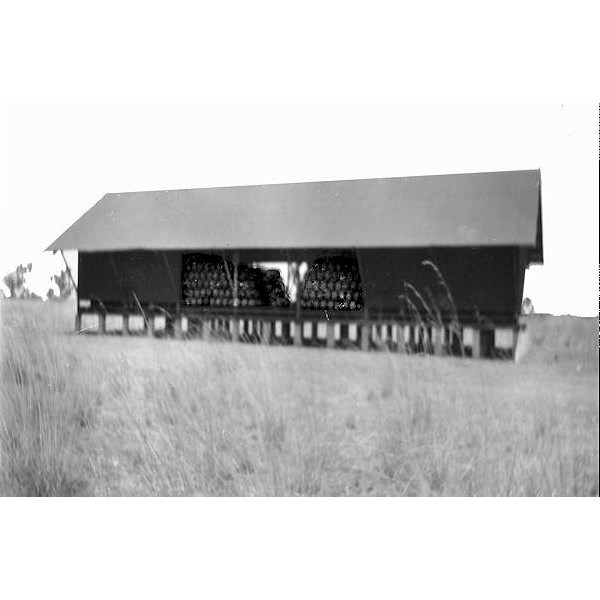
Chemical Weapons Storage Shed, Talmoi, Queensland with 250-lb bombs

Chemical weapons being trucked to the newly established chemical depot at 88 mile (near Adelaide River NT) in 1944
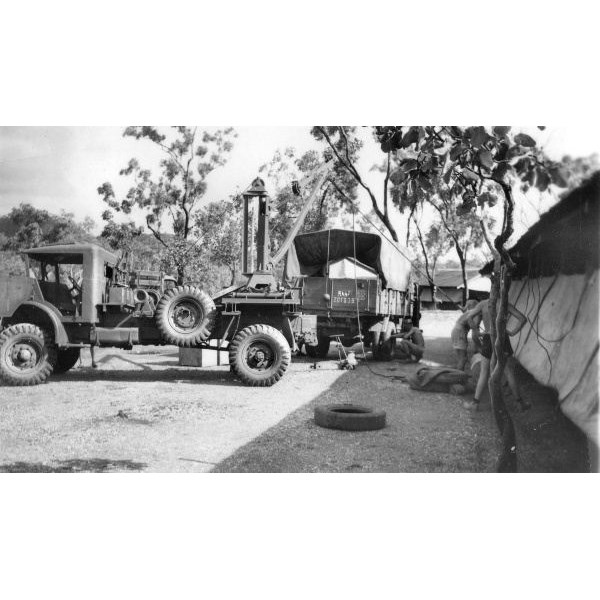
88 Mile Chemical Weapons Depot 18 miles South from Adelaide River
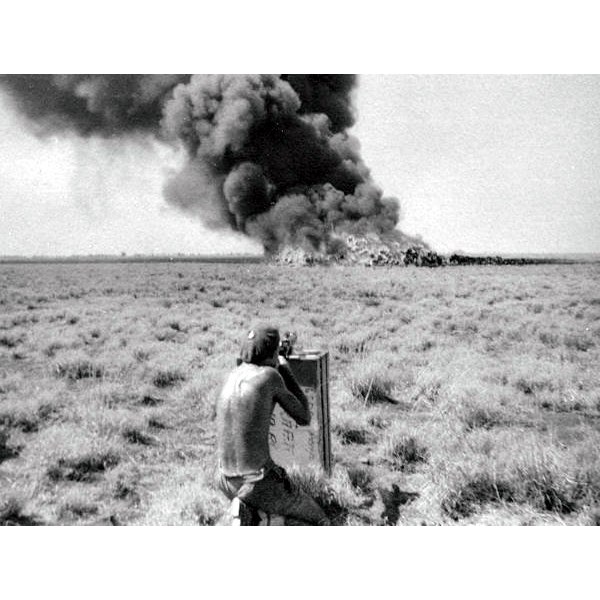
Firing incendaries into a chemical weapons burnoff at Tamoi after the war
The stocks at Marangaroo and Glenbrook were the last to be burned. The disposal took place in the
Newnes State Forest during February and March 1946 when 2000 tonnes were incinerated. Post war inspections showed that the burn had been incomplete and redisposal operations were conducted between 1947 and 1949, including reburning some items and the use of bleach. Final decontamination took place in 1980 when approximately 2500 tonnes of mainly soil residue were removed from the
Newnes State Forest burn site to the nearby Marrangaroo Ammunition Depot to be burned in a pit and bleached. Glenbrook later reverted to its former use as a mushroom
farm.
[In 1957, after a clearance operation of the former US CW storage depot at Darra,
Brisbane, CW contaminated soil33 was packed into 40-50 lb sacks and dumped into
the sea into 600 feet of water. In the Gillis Report, an eyewitness involved with CWA operations during the war remembers dumping mortars (number unspecified) in
Mourilyan Harbour. Originating from
Innisfail they had been fired experimentally. After firing, fifty percent were UXBs (unexploded bombs) which were sea dumped in order to avoid further mustard
gas contamination of the firing range. Other dumping operations appear to have been
undertaken off Queensland. A one ton cylinder of bulk mustard gas was encountered
by a trawler at 20º 42.8' S, 153º 35.7' E in 69 fathoms (19 January 1970) and later in
the 1970s a one ton cylinder came ashore in the same area. Two 155mm (6 inch) mustard gas (HD) filled projectiles have been recovered from the Moreton Bay area. It is understood that they were recovered during dredging operations in the shipping channel which passes
between
Moreton Island and
Bribie Island. About 5000 tons of CW munitions from the Army site at Albury is believed to have been disposed off
Sydney. The initial dumping operations consisted of loading chemical munitions into the hulks of ships damaged by enemy action or ships no longer required. These ships were towed to the dumping site and sunk using explosive
charges placed in the ship's keel (at both bow and stern) or by naval gunnery fire
using solid armour piercing rounds. Records exist for two of the dumped boats. These
were scuttled away from the main dump site 18
miles from
Sydney Heads. The first
ship used was the SS BANTAM which had been bombed and badly damaged at Oro
Bay, New Guinea 1943, It was towed to
Sydney and after the war was loaded with 27,500 chemical rockets, 8,000 4.2 inch chemical mortars and High Explosive shells. It was scuttled 136º Macquarie Light at 32
miles]
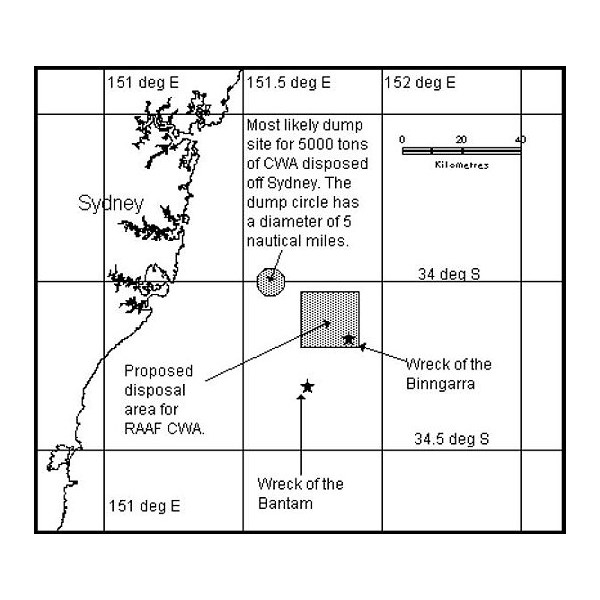
Chemical Warefare Agent Dump Areas Off Sydney
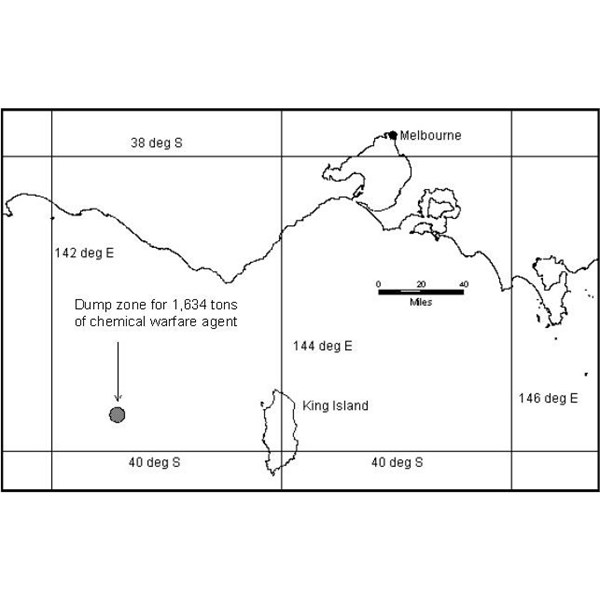
Chemical Warefare Agent Dump Areas Off Victoria

Likely dump area for 8000 tons of Chemical Warefare Agent Dumped Off Brisbane
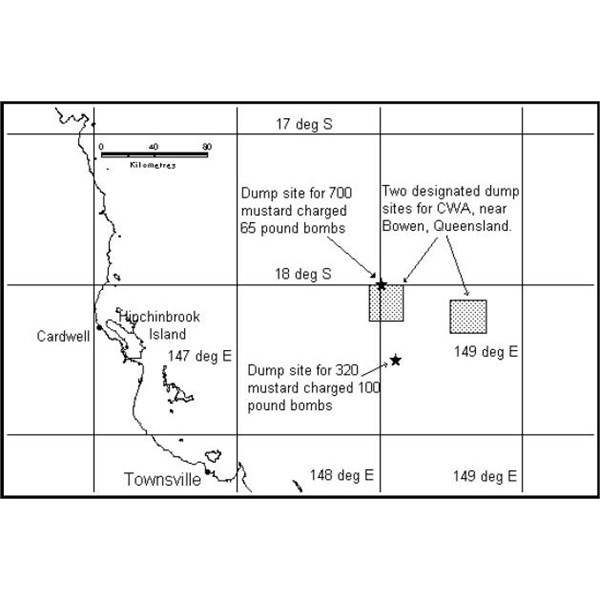
Chemical Warefare Agent Dump Areas Off Townsville
Glenbrook was considered the most pleasant of the tunnel depots by the men who worked with the gas. The site was described in 1943 as about 5km into the bush. The
camp consisted of the headquarters, orderly room a store, alcove for maintenance carpenter, mess hut with a big stone fireplace and an open fire to
cook on, masonite and wooden framed sleeping huts which had replaced tents. The huts had shutters at the top and bottom which could be propped open shower and
toilet blocks and a small transport section hut. Workers were required to do maintenance on the containers wearing gumboots, rubber gloves and heavy woollen clothing. Small burns were common if the men got gas on their skin. During the summer months RAAF staff from the Glenbrook
camp were called out to fight bushfires. The purpose of their presence at Glenbrook was a long held secret as was the testing and later disposal of the gas.
During operation the S curved, 650 metre tunnel was long and dark with widely spaced lighting. On the left hand side at the start of the tunnel were small containers, canisters in wooden crates. About midway canisters were located on one side and drums on the other. Further along, the sides that the canisters and drums were stored on were reversed. The tunnel had very little clearance, making it difficult for the trucks to back into the tunnel to load and unload the chemicals. The exterior ends of the tunnel were constructed of brick with stone capping. During WW2 the RAAF installed a concrete
grid floor in the tunnel and installed a telephone system for security purposes. It was apparently initially used by the RAAF to store 500lbs bombs.
Post World War Two, all four tunnels were used for mushroom growing purposes. However, Glenbrook Tunnel is the only tunnel which continues to be used for this purpose. In 1992 the lessee commenced growing exotic mushrooms not previously produced in Australia. Other tunnels not used for mustard gas storage have also been used as mushroom tunnels, including one at Mittagong and another near Helensburgh. The Marrangaroo storage tunnel has also been abandoned, while the Clarence tunnel forms part of the Zig Zag Tourist Railway and Picton has become a tourist attraction with a "ghostly past". The World War Two history of the tunnel's use was not widely known until the early twentyfirst century. This "hidden history" was the subject of significant interest when it was finally made known.
Stockage of Chemical Munitions, RAAF1
No. 1 Central Reserve (50
miles west of
Sydney)
8,000 bomb, 30-lb LC charged mustard
400 bombs, 65-lb LC (empty)
4,800 bombs, 250-lb LC charged mustard
3,600 bombs, 250-lb LC charged phosgene
200 bombs, 250-lb LC (empty)
570 SCI2 500 lb charged mustard
3 SCI 500 lb (empty)
75 SCI 250 lb (empty)
Stockage of Chemical Munitions, AUSTRALIAN ARMY1
Albury NSW
85,300 - 25 pounder shell, base ejection, filled BBC (tear gas)
258,000 - 25 pounder shell, base ejection, filled mustard
26,900 - 6 inch howitzer shell, base ejection, filled mustard
8,000 - 4.2 inch mortar bombs, filled phosgene
39,500 - 4.2 inch mortar bombs, filled mustard
22,500 - 5 inch rocket bomb, filled phosgene
3,900 - mines, chemical, filled mustard
Stockage of Chemical Munitions, US
Advance Chemical Depot, Aviation, Charters Towers, Queensland
81 tons mustard (H), in bulk
94 tons lewisite (L), in bulk
15 tons CNS, in bulk
23,500 bombs, M47A2, 100-lb (H)
100 bombs, M47, 100-lb (L)
600 bombs, M47, 100-lb (empty)
496 M10 spray tanks, empty
204 M20 spray tanks, empty
Kangaroo (SOS Dump) (26
miles North of
Townsville)
15,540 bombs M47A2, (H) 100-lb
18,168 - 75 mm gun(H)
14,370 - 75 mm howitzer (H)
198 - 105 mm howitzer (H)
1,401 - 155 mm howitzer (H)
1,171 - 155 gun (H)
300 DM Candles (toxic smoke)
Darra (near
Brisbane Queensland)
373 tons mustard (H), in bulk
101 tons lewisite (L), in bulk
82 tons tear gas solution (CNS) in bulk
4,945 bombs, empty, 100-lb
5,595 DM candles (toxic smoke)
5,489 - 105 mm howitzer (H)
Columboola (200
Miles west of
Brisbane)
26,023 bombs, (H) 100-lb
4,815 - 75 mm gun (H)
36,036 - 75 mm howitzer (H)
83,994 - 105 mm howitzer (H)
10,856 - 155 mm howitzer (H)
585 - 155 gun (H)
.